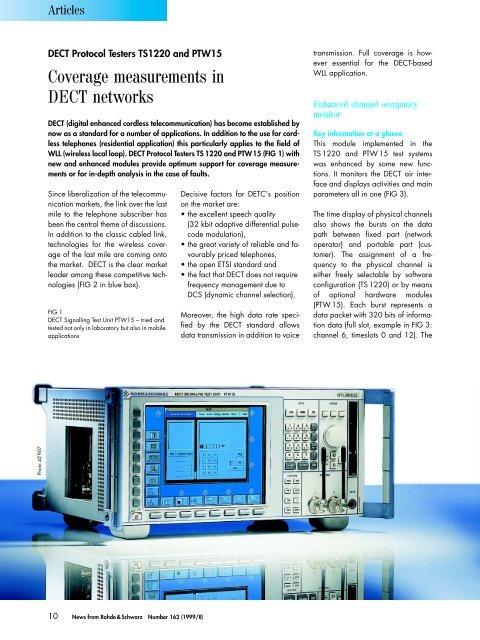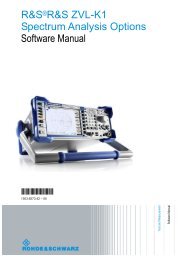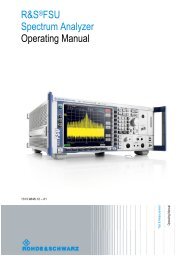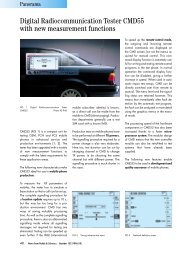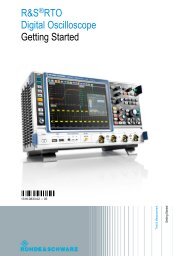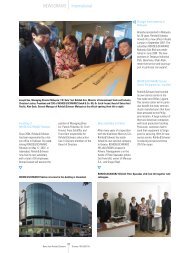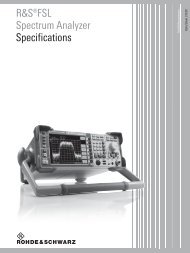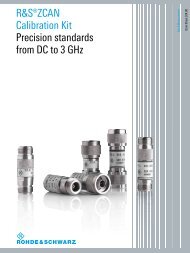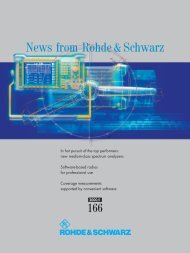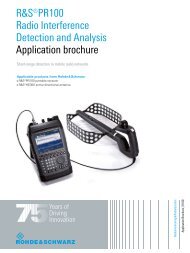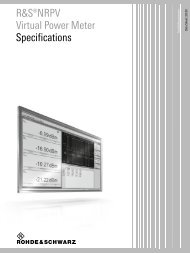Download article as PDF (0.5 MB) - Rohde & Schwarz
Download article as PDF (0.5 MB) - Rohde & Schwarz
Download article as PDF (0.5 MB) - Rohde & Schwarz
You also want an ePaper? Increase the reach of your titles
YUMPU automatically turns print PDFs into web optimized ePapers that Google loves.
Photo 42 907<br />
Articles<br />
DECT Protocol Testers TS1220 and PTW15<br />
Coverage me<strong>as</strong>urements in<br />
DECT networks<br />
DECT (digital enhanced cordless telecommunication) h<strong>as</strong> become established by<br />
now <strong>as</strong> a standard for a number of applications. In addition to the use for cordless<br />
telephones (residential application) this particularly applies to the field of<br />
WLL (wireless local loop). DECT Protocol Testers TS 1220 and PTW15 (FIG 1) with<br />
new and enhanced modules provide optimum support for coverage me<strong>as</strong>urements<br />
or for in-depth analysis in the c<strong>as</strong>e of faults.<br />
Since liberalization of the telecommunication<br />
markets, the link over the l<strong>as</strong>t<br />
mile to the telephone subscriber h<strong>as</strong><br />
been the central theme of discussions.<br />
In addition to the cl<strong>as</strong>sic cabled link,<br />
technologies for the wireless coverage<br />
of the l<strong>as</strong>t mile are coming onto<br />
the market. DECT is the clear market<br />
leader among these competitive technologies<br />
(FIG 2 in blue box).<br />
FIG 1<br />
DECT Signalling Test Unit PTW15 – tried and<br />
tested not only in laboratory but also in mobile<br />
applications<br />
10 News from <strong>Rohde</strong> & <strong>Schwarz</strong> Number 162 (1999/II)<br />
Decisive factors for DETC’s position<br />
on the market are:<br />
• the excellent speech quality<br />
(32 kbit adaptive differential pulsecode<br />
modulation),<br />
• the great variety of reliable and favourably<br />
priced telephones,<br />
• the open ETSI standard and<br />
• the fact that DECT does not require<br />
frequency management due to<br />
DCS (dynamic channel selection).<br />
Moreover, the high data rate specified<br />
by the DECT standard allows<br />
data transmission in addition to voice<br />
transmission. Full coverage is however<br />
essential for the DECT-b<strong>as</strong>ed<br />
WLL application.<br />
Enhanced channel occupancy<br />
monitor<br />
Key information at a glance<br />
This module implemented in the<br />
TS 1220 and PTW 15 test systems<br />
w<strong>as</strong> enhanced by some new functions.<br />
It monitors the DECT air interface<br />
and displays activities and main<br />
parameters all in one (FIG 3).<br />
The time display of physical channels<br />
also shows the bursts on the data<br />
path between fixed part (network<br />
operator) and portable part (customer).<br />
The <strong>as</strong>signment of a frequency<br />
to the physical channel is<br />
either freely selectable by software<br />
configuration (TS 1220) or by means<br />
of optional hardware modules<br />
(PTW 15). Each burst represents a<br />
data packet with 320 bits of information<br />
data (full slot, example in FIG 3:<br />
channel 6, timeslots 0 and 12). The
6% analog cellular systems<br />
12% other cordless systems<br />
14% proprietary PMP<br />
18% proprietary digital<br />
cellular systems<br />
10% GSM<br />
8% other digital cellular systems<br />
32% DECT<br />
height of the burst is proportional to<br />
the field strength, which simplifies the<br />
determination of the transmission<br />
quality in a first approximation.<br />
The DECT air interface can show the<br />
activities of different applications at<br />
the same time, eg when WLL and residential<br />
activities (cordless telephones)<br />
are performed within the receive<br />
range of the DECT test equipment.<br />
Since the DECT specification allows<br />
for non-synchronous activities,<br />
sliding collisions between the connections<br />
may occur. It is very important to<br />
detect such situations. With the aid of<br />
the channel occupancy monitor, the<br />
different activities can be displayed<br />
in different colours. For instance,<br />
FIG 3 shows<br />
the reference activity,<br />
activities synchronized to the reference<br />
(in the same network),<br />
<strong>as</strong>ynchronous activities, eg private<br />
telephones.<br />
The right-hand window of the display<br />
provides detailed numerical information<br />
on the individual activities in datab<strong>as</strong>e<br />
format. This information<br />
mainly includes channel and timeslot,<br />
receive level, sync state (reference,<br />
slot-synchronous, frame-synchronous,<br />
multiframe-synchronous, <strong>as</strong>ynchronous),<br />
preamble (fixed or portable),<br />
identification codes and messages<br />
of broadc<strong>as</strong>t channel Q (capabilities).<br />
About DECT<br />
FIG 2<br />
Different WLL technologies<br />
in comparison<br />
(source: DECT<br />
forum)<br />
Statistical evaluation<br />
The main display window of the channel<br />
occupancy monitor shown in<br />
FIG 3 illustrates an instant of the<br />
DECT interface (snapshot). Statistical<br />
evaluation of a great number of snapshots<br />
is however required for <strong>as</strong>sessing<br />
the quality or analyzing a fault.<br />
FIG 3 Channel occupancy monitor<br />
For this purpose the module continually<br />
saves the datab<strong>as</strong>e content in a<br />
file (a data record corresponds to a<br />
snapshot). The parameters to be<br />
stored can be selected from a table<br />
and may be complemented by superordinate<br />
units. This particularly<br />
applies to local coordinates obtained<br />
from a GPS receiver. If this receiver is<br />
Articles<br />
DECT is used worldwide on the following frequencies:<br />
Europe<br />
(and others): 1897.344 MHz to 1881.792 MHz 10 channels<br />
China: 1902.528 MHz to 1918.080 MHz 10 channels<br />
Latin America: 1912.896 MHz to 1928.448 MHz 10 channels<br />
All other RF parameters such <strong>as</strong> modulation (GFSK), power (max.<br />
24 dBm) and channel spacing (1.728 MHz) are identical<br />
equipped with a standardized<br />
NMEA (National Marine Electronics<br />
Association) interface, the coordinates<br />
can be directly read in and<br />
stored via an RS-232-C interface.<br />
FIG 4 shows the parameter selection<br />
window and the <strong>as</strong>sociated ASCII<br />
file. Export filters (eg to Microsoft<br />
EXCEL) are also available.<br />
New: the simulation module<br />
Under certain circumstances p<strong>as</strong>sive<br />
monitoring is not sufficient for analyzing<br />
a scenario and the test system<br />
News from <strong>Rohde</strong> & <strong>Schwarz</strong> Number 162 (1999/II) 11
Articles<br />
needs to actively simulate one of the<br />
partners in the DECT network. The implementation<br />
of a GAP (generic access<br />
profile) compatible fixed part<br />
and portable part <strong>as</strong> a reference h<strong>as</strong><br />
always been a function of the two test<br />
systems. Many manufacturers of<br />
DECT terminals are no longer satisfied<br />
with just transmitting voice, they<br />
are working on the implementation of<br />
data transmission facilities (transparent<br />
ISDN channel). The data rate required<br />
by DECT for this application is<br />
provided by slot coupling (double<br />
slot). This technique with <strong>as</strong>sociated<br />
protocol support (advanced connection)<br />
is available <strong>as</strong> an option for Protocol<br />
Tester TS 1220 (FIG 5).<br />
Protocol Testers TS 1220 and PTW 15<br />
from <strong>Rohde</strong> & <strong>Schwarz</strong> are ready for<br />
future applications and of course also<br />
ideal for the development of such<br />
applications.<br />
Detlef Willam<br />
FIG 5 Protocol Tester TS1220 also analyzes<br />
double-slot connections with the aid of the<br />
<strong>as</strong>sociated protocol support (advanced connection)<br />
REFERENCES<br />
[1] Gloger, M.; Riedel, P.: DECT Protocol<br />
Tester TS1220 – Type-approval me<strong>as</strong>urements<br />
on DECT fixed parts (FP) and portable<br />
parts (PP) to TBR 22. News from<br />
<strong>Rohde</strong> & <strong>Schwarz</strong> (1995) No. 148,<br />
pp 9 – 11<br />
[2] Jauch, H.; Riedel, P.: DECT Signalling Test<br />
Unit PTW15 – Support in installation and<br />
maintenance of DECT networks. News<br />
from <strong>Rohde</strong> & <strong>Schwarz</strong> (1997) No. 155,<br />
pp 4 – 5<br />
12 News from <strong>Rohde</strong> & <strong>Schwarz</strong> Number 162 (1999/II)<br />
FIG 4<br />
Statistical evaluation: parameter selection<br />
window (right) and <strong>as</strong>sociated ASCII file<br />
Condensed data for channel occupancy (TS1220)<br />
TS 1220 PTW 15<br />
Scans/s >12 >3<br />
Resolution (time)


